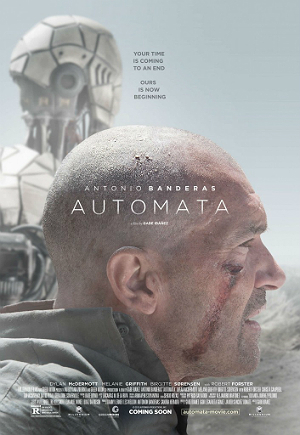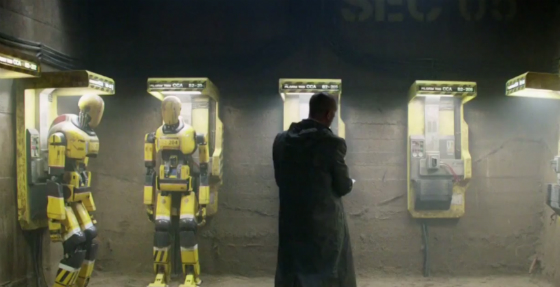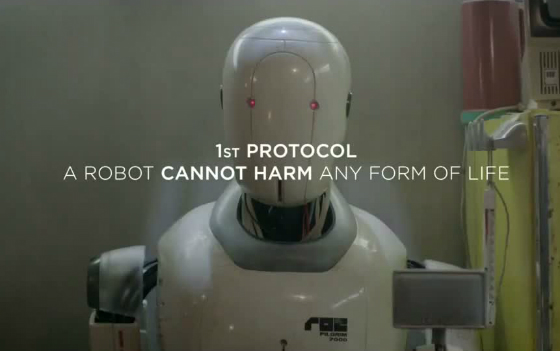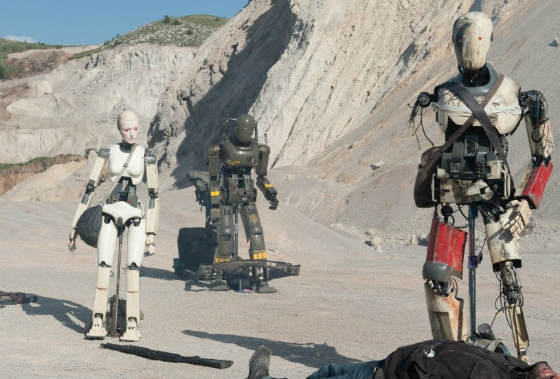TR Interview: Automata‘s “Visionary” Director Gabe Ibanez on His Asimov Riff
 |
When I first saw the trailer for Automata, I assumed that it was a big-budget studio release that I’d just somehow missed out on hearing about. It stars Antonio Banderas, and it has top-notch special effects and a fully realized future world. But no – this is a scrappy indie from a first-time feature director, and is probably too weird and brooding for a studio, which is a good thing. Like a kinder, gentler, Blade Runner, it has Banderas going around fixing rogue robots rather than killing them…but it’s all against the backdrop of humanity gradually going extinct.
I spoke to Ibanez on the phone during Fantastic Fest. As he is a fast-talker with a thick accent, I cannot vouch for every single word, but I’m pretty sure it’s essentially all there.
Gabe Ib??ez: Hi, Luke. I’m Gabe.
Luke Y. Thompson: Hi, how are you?
GI: Pretty well. How are you?
LYT: Very good. Are you at Fantastic Fest right now?
GI: Yeah. I’m in the hotel. In a few minutes, I will go up to the theater, because it’s going to be the United States premiere of the movie.
LYT: OK, so it’s just about to happen. That’s got to be exciting.
GI: Yes. It’s great to be here with this movie. It’s the kind of movie that people will be happy to see here.
LYT: When the first trailer came out and it calls you a visionary director, I think a lot of us were like, “Who is this visionary? Where is he coming from?” So what’s your background? Where are you from? Were you surprised to be called a visionary in the trailer?
GI: Believe me, I asked the studio to remove this word! It looks like a very strange way to present a director as visionary. I asked to remove this word from the trailer; but they didn’t do it. I don’t think I am visionary. In fact, I work in a very classic science fiction universe. What I love is the classic science fiction, and the kind of movie we are trying to do – this movie is like the ’60s and the ’70s classic science fiction movies, like The Andromeda Strain and Planet of the Apes, and this movie has like, philosophical conflict behind it, and uses the science fiction to make something maybe more odd, maybe a little serious, but I use the science fiction to talk about human beings. That’s what we want to do – something very classic – so maybe visionary is not there in this work.
 |
LYT: It’s also – you probably get this a lot, but it reminded me of Blade Runner in reverse. Instead of a guy going out to hunt these robots who are gaining self-awareness, he’s going to fix them, which is a little bit of a twist on it.
GI: Yes. You know, I grew up with those books – my grandfather loves science fiction. He has a lot of books from Isaac Asimov and Stanislaw Lem, those people. So I grew up with these books, and I read Asimov, and I liked very much the Asimov universe. I loved the way he worked in his books with the robotic laws. Of course, we did something different. We don’t use the Asimov laws – we only use the one, the first law. Again, this is not a robotic law – it’s a law of revenge, so you won’t kill a man. And we changed them. We use a similar knowledge to work too – when playing with these roles, you create a story line, and this is part of our intention, and this is part of what we are doing.
And of course, Blade Runner, you are doing a futuristic city, and it’s rainy and darkness – it’s very easy to be around Blade Runner. But believe me, the references are more in the ’60s and ’70s science fiction movies, and of course many things that work around Blade Runner, and even before Blade Runner, like Moebius, was using these kind of dark, dreary cities with a lot of elements.
Anyway, I love Blade Runner. Science fiction is something that, like jazz music – you use very similar elements, and the combination of these elements is what makes the difference between one movie and the other. How we combine these elements in Aut?mata is what makes Aut?mata different – or just the mix of elements.
 |
LYT: I wanted to ask, actually, about the robotics laws you have in the movie. One of them is that a robot can’t harm any living thing, and we see that that involves the family pet, but how far does that go? Would a robot not be able to harm a plant, or a fly, or a bacteria? Is it really every living thing, or is there a cut-off point?
GI: Of course, if you are talking about a bacteria, we are very far from realistic dealings about living beings. The robots can merely try to preserve any kind of living being, and that is something that works as a generic law. You know, this is how robotics are supposed to develop in the story line – it’s not something that we try to preserve 100%. It’s just something to serve, it’s something to help develop the story, and to define the robots as moral robots. That’s something that is important for the role. You can see that in the movie robots are like insects on the spine of humans, and they don’t feel anything.
LYT: How did you come about the design for the robots? You want this gray line of having them be very alien looking, in a way, but you also have to identify with them a little bit in the end. How did you come up with that balance?
GI: Yeah, at the end we decide what’s important is don’t try to be very human, really very human-like. We were working in trying to define the robots like something, like a machine you have in your home, like the fridge or the washing machine, or something like that. The kind of life that the robots have in the movie have to be something different to human life. You don’t want to make very human-like robots. In fact, with the end in sight, the robots had to be practical, so we created the robots, and the robots are real on the set, and they work with the actors in a very real way.
We used puppeteers to move the robots, and we tried to be very realistic, very like an object that is there in your home. We then tried to make something very live that moved, a very animated – something very simple, something that is there, and something that is not spectacular, but is real. That’s the reason we designed it that way.
LYT: Was there any motion capture used off of people, or was it all purely mechanical?
GI: No, it’s all real. It’s not any kind of CGI for the robot. The robots are physical, and were on the set, and there are a group of puppeteers moving each robot. Then we removed the puppeteers using CGI, but the robots are real – objects that are there. Two days ago was the premiere at the San Sebasti?n Film Festival, and we took the robots to the festival there with the actors. It’s a difficult technique. It’s a very old-fashioned system, but my background is in computer graphics, and I have been working many years as a visual effects supervisor, and digital artist, and I think that in this kind of realistic movie is better to use real objects. Not stop-motion, not motion capture – just people moving objects. It’s very old-fashioned, it is difficult to shoot that way, but in the end, I think it gives personality to the movie.
 |
LYT: So it was puppeteers activating [the robots]. Were these people who had a background in puppetry, or was it more general special effects people?
GI: No, we worked in Bulgaria, and in Bulgaria there is a big tradition of puppeteers. We already had a lot of people that were puppeteers. So we worked with special effects people from the States, but also with special effects people from Buglaria, and these puppeteers that work in theater for children and this kind of thing. We find these hassles in defining exactly how it has to be moved, and the material we need to do this, but at the end I was quite happy.
The robots have their own personality, and the fact to be real and to be there on the set gives to the actors the chance of working in a very realistic way, and had the work kind of relation between the robot and the actor. Every day on the set, it was like part of the crew – they are almost real, they are there every day. Very different to when you are working with computer graphics. No, robots are important in the movie, so I prefer to have something real.
LYT: How did you assemble such a great cast for this film?
GI: Antonio Banderas was the first one who read the script. He was very passionate about the story, and he was working as a producer to make this. The cast I have – people like Melanie Griffith is there, of course, because of Antonio; Antonio asked the favor of Melanie. Also Javier Bardem is doing one of the voices of the robot, and is also because of Antonio.
The other actors like Dylan McDermott or Robert Forster are really great actors that are in the environment of the company. They work with the company usually with Millennium. Millennium gives me the opportunity of choosing. It was great to have Dylan McDermott or Robert Forster for these roles, and all of these people were very fascinated with the script, and it was great. For me, I have only done one movie before, and I don’t have a big experience in movies. To work with these people who are such very good actors, and so passionate – it makes everything easier.
LYT: Congratulations, and thanks, and have a good premiere tonight!
GI: Thank you very much! Let’s see how it works. It’s going to be fun, anyway.
LYT: All right. Thank you Gabe.
GI: Thank you, Luke. Thank you very much for your questions.
—
Automata opens today.
